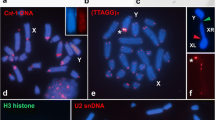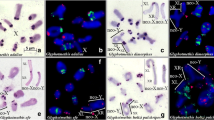Abstract
Sex chromosomes in species of the genus Microtus present some characteristic features that make them a very interesting group to study sex chromosome composition and evolution. M. cabrerae and M. agrestis have enlarged sex chromosomes (known as ‘giant sex chromosomes’) due to the presence of large heterochromatic blocks. By chromosome microdissection, we have generated probes from the X chromosome of both species and hybridized on chromosomes from six Microtus and one Arvicola species. Our results demonstrated that euchromatic regions of X chromosomes in Microtus are highly conserved, as occurs in other mammalian groups. The sex chromosomes heterochromatic blocks are probably originated by fast amplification of different sequences, each with an independent origin and evolution in each species. For this reason, the sex heterochromatin in Microtus species is highly heterogeneous within species (with different composition for the Y and X heterochromatic regions in M. cabrerae) and between species (as the composition of M. agrestis and M. cabrerae sex heterochromatin is different). In addition, the X chromosome painting results on autosomes of several species suggest that, during karyotypic evolution of the genus Microtus, some rearrangements have probably occurred between sex chromosomes and autosomes.
Similar content being viewed by others
References
Ashley T (2002) X-autosome translocations, meiotic synapsis, chromosome evolution and speciation. Cytogenet Genome Res 96: 33–39.
Bullejos M, Sánchez A, Burgos M et al. (1999) Multiple mono- and polymorphic Y-linked copies of the SRY HMG-box in Microtidae. Cytogenet Cell Genet 86: 46–50.
Burgos M, Jiménez R, Diaz de la Guardia R (1986) A rapid, simple and reliable combined method for G-banding mammalian and human chromosomes. Stain Technol 61: 257–260.
Burgos M, Jiménez R, Díaz de la Guardia R (1988a) Comparative study of G- and C-banded chromosome of five species of Microtidae: a chromosomal evolution analysis. Genome 30: 540–546.
Burgos M, Jiménez R, Olmos DM et al. (1988b) Heterogeneous heterochromatin and size variation in the sex chromosome of Microtus cabrerae. Cytogenet Cell Genet 47: 75–79.
Burgos M, Olmos DM, Jiménez R et al. (1990) Fluorescence banding in four species of Microtidae: an analysis of the evolutive changes of the constitutive heterochromatin. Genetica 81: 11–16.
Chaline J, Graf JD (1988) Phylogeny of the Arvicolidae (Rodentia): Biochemical and paleontological evidence. J Mamm 69: 22–33.
Chowdhary BP, Raudsepp T (2001). Chromosome painting in farm, pet and wild animal species. Methods Cell Sci 23: 37–55.
Díaz de la Guardia R, Pretel A (1979) Comparative study of the karyotypes of two species of water vole: Arvicola sapidus and Arvicola terrestris (Rodentia, Microtinae). Caryologia 32: 183–189.
Fernández R, Barragán MJL, Bullejos M et al. (2001) Molecular and cytogenetic characterization of highly repeated DNA sequence in the vole Microtus cabrerae. Heredity 87: 637–646.
Fernández R, Barragán MJL, Bullejos M et al. (2002) Mapping the SPY gene in Microtus cabrerae: a vole species with multiple SPY copies in males and females. Genome 45: 600–603.
Graves JA (1995) The evolution of mammalian sex chromosome and the origin of sex determining genes. Phil Trans R Soc Lond B Biol Sci 350: 305–312
Howell RT, Millener R, Thorne S et al. (1994) Elucidation of structural abnormalities of the X chromosome using fluorescence in situ hybridisation with a Y chromosome painting probe. J Med Genet 31: 206–208.
Jiménez R, Carnero A, Burgos M et al. (1991) Achiasmatic giant sex chromosome in the vole Microtus cabrerae (Rodentia, Microtidae). Cytogenet Cell Genet 57: 56–58.
Kalscheuer V, Singh AP, Nanda I et al. (1996) Evolution of the gonosomal heterochromatin of Microtus agrestis: rapid amplification of a large, multimeric, repeat unit containing a 3.0-kb (GATA)11-positive, middle repetitive element. Cytogenet Cell Genet 73: 171–178.
Kholodilov NG, Mayorov VI, Mullokandov MR et al. (1993) LINE-1 element in the vole Microtus subarvalis. Mamm Genome 4: 624–626.
Lee C, Griffin DK, O’Brien PC et al. (1998) Defining the anatomy of the Rangifer tarandus sex chromosomes. Chromosoma 107: 61–69.
Marchal JA, Acosta MJ, Bullejos M et al. (2003) Sex chromosomes, sex determination and sex linked sequences in Microtidae. Cytogenet Genome Res 10: 266–273.
Mayorov VI, Rogozin IB, Adkison LR (1999) Characterization of several LINE-1 elements in Microtus kirgisorum. Mamm Genome 10: 724–729.
Megías-Nogales B, Marchal JA, Acosta MJ et al. (2003) Sex chromosomes pairing in two Arvicolidae species: Microtus nivalis and Arvicola sapidus. Hereditas 138: 114–121.
Modi WS (1987a) Phylogenetic analyses of chromosomal banding patterns among the Neartic Arvicolidae (Mammalia, Rodentia). Sys Zool 36: 109–136.
Modi WS (1987b) C-banding analyses and the evolution heterochromatin among arvicolid rodent. J Mamm 68: 704–714.
Modi WS (1993a) Comparative analysis of heterochromatin in Microtus: sequence heterogeneity and localized expansion and contraction of satellite DNA arrays. Cytogenet Cell Genet 62: 142–148.
Modi WS (1993b) Rapid, localized amplification of a unique satellite DNA family in the rodent Microtus chrotorrhinus. Chromosoma 102: 484–490.
Müller S, Stanyon R, O’Brien PC et al. (1999) Defining the ancestral karyotype of all primates by multidirectional chromosome painting between tree shrews, lemurs and humans. Chromosoma 108: 393–400.
Nadachowski A (1991) Systematic, geographic variation and evolution of snow voles (Chionomys) based on dental characters. Acta Teriol 36: 1–45.
Nanda I, Neitzel H, Sperling K et al. (1988) Simple GATCA repeats characterize the X chromosome heterochromatin in Microtus agrestis, European field vole (Rodentia, Cricetidae). Chromosoma 96: 213–219.
Neitzel H, Kalscheuer V, Henschel S et al. (1998) Betaheterochromatin in mammals: evidence from studies in Microtus agrestis based on the extensive accumulation of L1 and non-L1 retroposons in the heterochromatin. Cytogenet Cell Genet 80: 165–172.
Neitzel H, Kalscheuer V, Singh AP et al. (2002) Copy and paste: the impact of a new non-L1 retroposon on the gonosomal heterochromatin of Microtus agretis. Cytogenet Genome Res 96: 179–185.
Nesterova TB, Duthie SM, Mazurok NA et al. (1998) Comparative mapping of the X chromosome in vole species of the genus Microtus. Chromosome Res 6: 41–48.
O’Brien SJ, Seuanez HN, Womack JE (1988) Mammalian genome organization: an evolutionary view. Annu Rev Genet 22: 323–351.
Raudsepp T, Lear TL, Chowdhary BP (2002) Comparative mapping in equids: the asine X chromosome is rearranged compared to horse and Hartmann’s mountain zebra. Cytogenet Genome Res 96: 206–209.
Sánchez A, Burgos M, Jiménez R et al. (1989) Variable conservation of nucleolus organizer regions during karyotypic evolution in Microtidade. Genome 33: 119–122.
Sharp P (1982) Sex chromosome pairing during male meiosis in marsupials. Chromosoma 86: 27–47.
Singh AP, Henschel S, Sperling K et al. (2000) Differences in the meiotic pairing behavior of gonosomal heterochromatin between female and male Microtus agrestis: implication for the mechanism of heterochromatin amplification on the X and Y. Cytogenet Cell Genet 91: 253–260.
Toder R, Wienberg J, Voullaire L et al. (1997) Shared DNA sequences between the X and Y chromosomes in the tammar wallaby — evidence for independent additions to eutherian and marsupial sex chromosomes. Chromosoma 106: 94–98.
Wilcox SA, Watson JM, Spencer JA et al. (1996) Comparative mapping identifies the fusion point of an ancient mammalian X-autosomal rearrangement. Genomics 35: 66–70.
Author information
Authors and Affiliations
Corresponding author
Rights and permissions
About this article
Cite this article
Marchal, J.A., Acosta, M.J., Nietzel, H. et al. X chromosome painting in Microtus: Origin and evolution of the giant sex chromosomes. Chromosome Res 12, 767–776 (2004). https://doi.org/10.1007/s10577-005-5077-0
Received:
Accepted:
Issue Date:
DOI: https://doi.org/10.1007/s10577-005-5077-0




